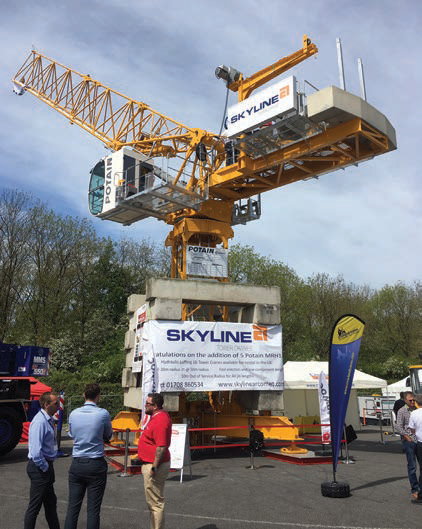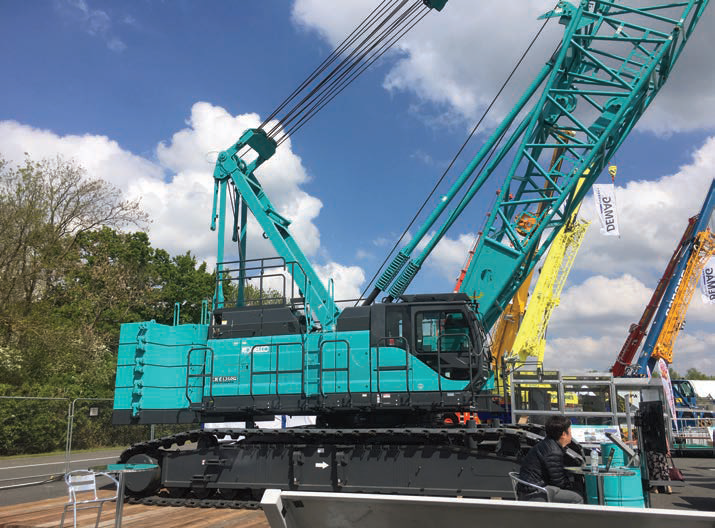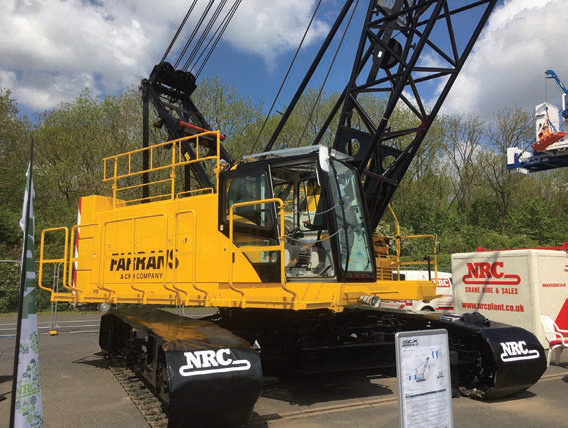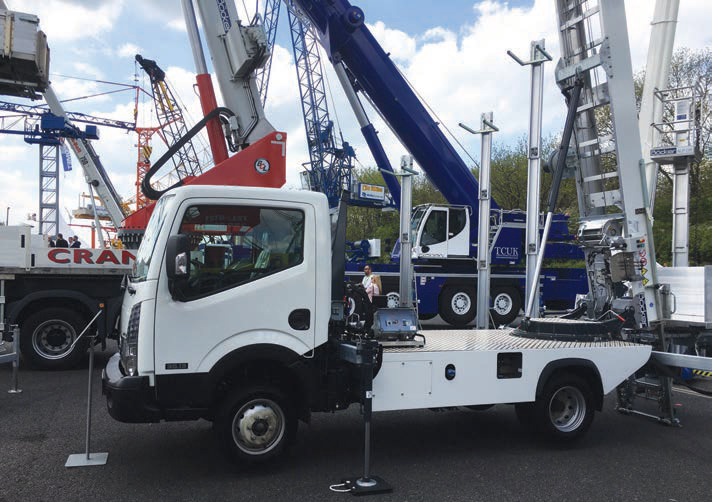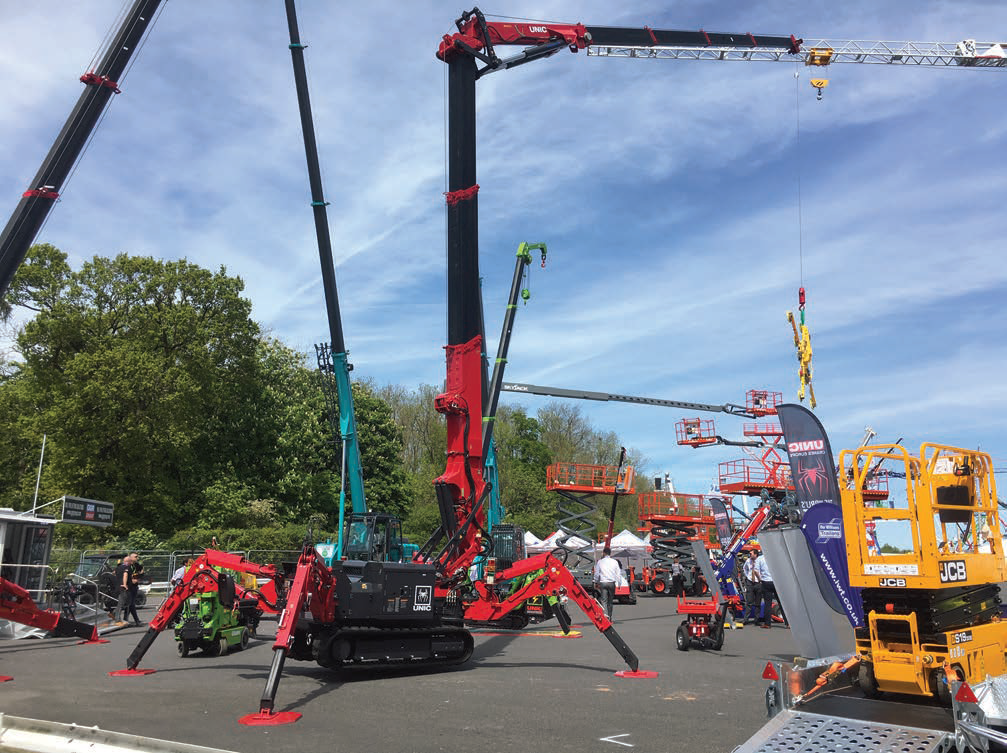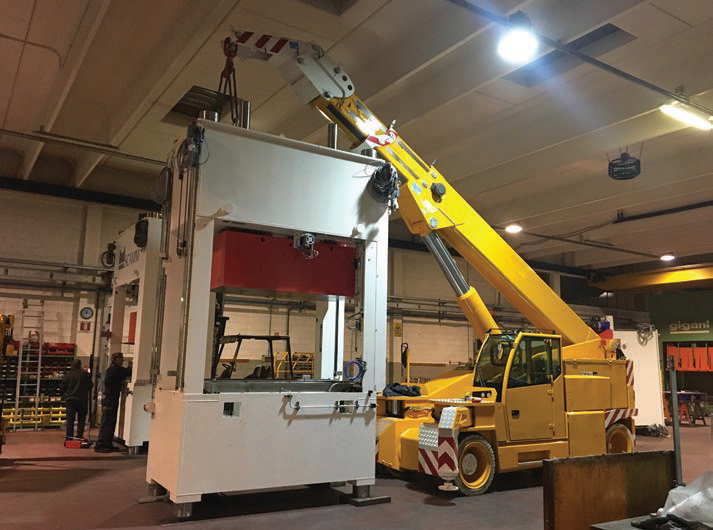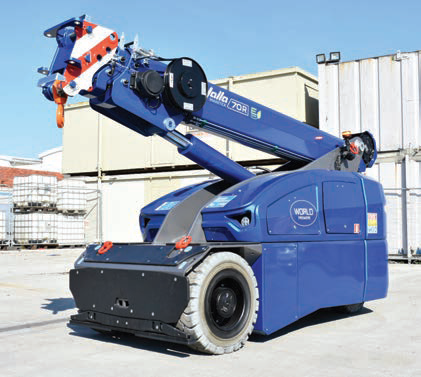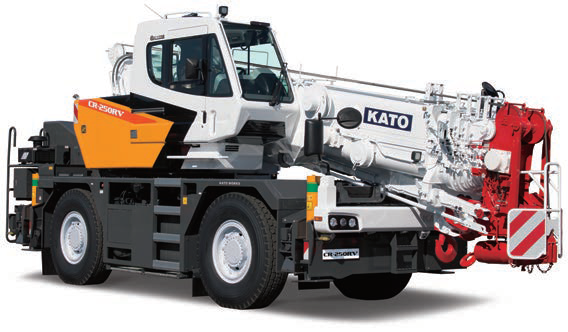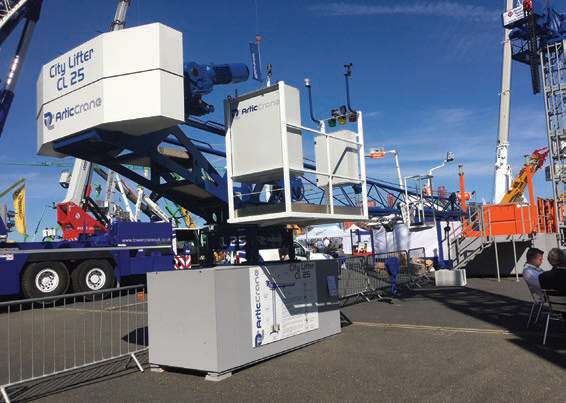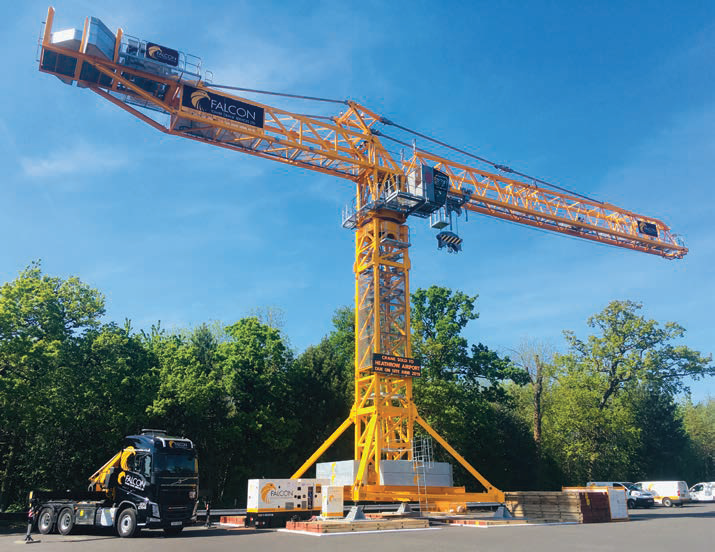An uncommon market
17 July 2019The Vertikal Days show, in May this year, showed a UK crane market that is far from on hold. Julian Champkin found an air of optimism and very many new introductions.
I do apologise, but I shall have to begin with Brexit. No survey of the state of the UK market, in cranes or in anything else, can ignore it. However, if you are already sick to death of the subject – and I would not blame you – do not worry; it is not as bad as you might think, and if you skip to the fifth paragraph down we shall probably be over it by then and be getting back to cranes.
Conventional wisdom says that Brexit uncertainty has put everything in the UK on hold. Nobody knows what is happening come October or whenever; so nobody can do anything, we are stuck in a limbo of fog-bound uncertainty and all investment and forward planning has ground to a halt.
In the crane and lifting sector, conventional wisdom would seem to have got it wrong. In the experience of almost all who exhibited at Vertikal Days (15-16 May 2019) it has been business as usual, or even better than usual. There has been no lack of confidence from the building and infrastructure industries who are crane customers and endusers; nor therefore from crane manufacturers, importers, dealers and renters who survive and, one hopes, flourish, by supplying them. Building, and business, they say, is booming; and everyone is keeping calm and carrying on.
New models were introduced. Some had been shown just six weeks before at Bauma in Munich and were being shown in the UK for the first time; some were completely new; and some were specifically aimed at the UK market—which shows, if nothing else, confidence that there will still be a UK market after Brexit.
Foster Cranes have been a dealer in used mobile cranes since 1995. “There was a bit of a dip in the used crane market immediately after the Brexit vote,” said Danny Williams, sales and marketing director, “but since then, we have had a record year for used mobile cranes sales. As well as this, we are pleased to have entered the compact crane market: As of July 2018 we have been the UK dealer for Hoeflon compact cranes, introducing the future of compact cranes to the UK.” Hardly, then, a lack of either planning or investment.
Also in the mini-field, JMG were showing electric pick and carry cranes; the 35t MC 350 has front wheels drive, radio remote control and AC electric motors. Battery capacity gives eight working hours. If the load radius and weight are higher than can be lifted normally, front stabilisers can be deployed during the lift, which gives extra lifting capacity while keeping safe working conditions. The load can then be brought closer to the machine, reducing the lift radius to one safe to travel with. Then the stabilisers can be withdrawn, and the pick and carry operation can continue.
GGR were displaying a minicrane new to the UK at Vertikal Days, the UNIC 295-3 spider, able to lift 2.9t at 1.4m. Its special feature is that the outriggers are adjustable and variable, so the crane can be used in narrow spaces where there are fixed obstructions. Load limits for the outrigger arrangement are displayed on a new 7-inch colour screen. “It was launched at Bauma in April, but this is its first time in the UK” said Daniel Ezzatvar, marketing manager; “and since then we have launched the GK20 pick-and-carry compact crawler and two other models as well. That is four new models in three months, with more to come – so we are definitely not stuck in a Brexit limbo.”
Also in the mini-crane sector Hird were showing the Valla 70R, R standing for radio control. It is fully wireless, and with an adjustable counterweight, it is a pick-andcarry mini-teleboom with a 7.7t capacity, It can be fitted with a winch, hydraulic luffing fly jib and counter balance fork attachments from the factory with a multi position boom head, fitted with a fixed hook to further reduce restricted head room clearance. When fitted with a suction attachment it can act also as a glazing robot. The crane is battery powered and comes with an on board battery charger; with AC motors and solid state controllers the crane reduces battery power consumption, further demonstrating its eco credentials. The wireless radio remote control operates all drive and lift functions from one controller.
The selling point of this machine, apart from its futuristiclooking design, is its narrow 1.4m width. “The radio control means that it does not need a cab, which means in turn that it can be made much narrower than previous generation models” said Carl Cooper, Hird/Valla Cranes sales and after-sales manager. “It can work outside, but it is designed for clean-room environments, as well as confined and restricted areas. With no noise and no fumes the battery powered cranes are more and more being sourced after to replace diesel and LPG powered counterparts. We’ve had a lot of interest and people looking at it. It is very ergonomic and pretty. It was shown at Bauma, but this is the first time it is being shown in the UK. ”
“There are no Brexit blues. Demand is still there” said Barbara Brown of Falcon Tower Crane Services, whose Jaso J560, shortly to be installed at Heathrow, was prominently placed at the show entrance. “I was surprised, as everyone was expecting business to start slowing down. But, the order levels have remained constant. And that applies also to the number of applicants for the training courses that Falcon run; again a sign, on the part of trainees and their sponsors, of confidence in the future.”
There were only two large lattice crawlers on display at Vertikal Days, but this was more because only a few companies manufacture them than for any lack of demand for them – or any lack of work that they can do. One was Kobelco’s new 150t G-2 series CKE1350.
“Lattice crawlers are a specialised field” said Mark Evans, their European sales manager. “There is work around. It is a consistent market and business is good. There is potential, growing over the months, for infrastructure projects. HS2 is huge, with significant sectors in it for lattice crawlers that should last for years.
"We have just put four crawlers into Hinkley Point nuclear power station, two CKE900s and two CKE1350s, and they will need more of them there. Heathrow expansion will need crawlers, and Thames Tideway work continues. It has been a steady year so far; we have been delivering machines throughout the first five months. We sold a CKE300G to SECH after they saw it at Bauma; today I have just sold a CKE1350, with a 61m boom and 30.5m fixed fly-jib, to G.H. Johnson, the rental company. Business is steady and we are still delivering machines to customers and getting a number of inquiries, from new customers as well as from our regulars.”
“There is a steady demand for teleboom crawlers as well” he says. “This is something that Kobelco are looking into. We do make a range of them, but so far only for the Asian market, and currently they do not have CE approval so we cannot deliver them into Europe. In the under 100t capacity range demand for telebooms is increasing at the expense of lattice booms so we would like to introduce our TK telebooms but with Tier 5 engines in our plans for that range. Major contractors want their ability to work in confined spaces – just the sort of spaces that are often associated with major projects.”
The other lattice crawler on show was HSC Cranes's SCX800A-3 at the NRC stand. “There is definitely a need for lattice crawlers,” said NRC operations manager Dave Rees. “It is true that there has been a shift in demand. At 55-60t capacities it is almost all now telescopics, and now they are eating into the market for capacities of up to 80t. It is because of ease of rolling out the crane on site; they can arrive ready to work, without assembly. But the market really is all about lifting capacity, and from that point of view the lattice is far better. Both types are as easy to operate, but lattices offer better load charts. And there are plenty of UK infrastructure projects for them.” Again he mentioned Thames Tideway, HS2 and Hinkley Point. “All that is happening and we are looking to renew our fleet to make it younger and greener. We are not necessarily expanding our fleet: we want to offer the best fleet, not the biggest, for our customers. Until recently we capped our rental cranes capacities at 150t. Now our rental fleet ranges from 5t minis up to our 275t SCX2800A-3 lattice crawler, which has 60m of main boom. That last one is a big investment; but it is a natural progression for our business and means we can offer our customers a really wide range.”
He and others pointed to a factor more important that Brexit: exchange rates, for both hirers and importers and distributors. “Rental rates are a little bit down, but then exchange rates are far more of a factor when selling cranes. Sterling against the dollar and sterling against the yen are important, and that is something that is outside our control. There is nothing we can do about those, and of course it affects prices, for all manufacturers” he said. “But confidence is still there. People may be a little hesitant, and the uncertainty may make them err a little on the side of caution, but not to the extent of greatly affecting things.”
As witness the fact that he had just sold the large SCX800A-3 lattice crawler that was on display, to Farrans in Northern Ireland.
Colin Cleary of Rivertek agrees with the analysis. “If the product is good and people can see the opening for it, they will take the risk and invest” he said. “We have sold two cranes so far at the show. A Kato CR-250Rv, 25t City Range crane, which is making its UK debut here and a Kato CR-200Rf, 20t City Range crane also.”
At the other end of the project scale is house-building. Böcker makes aluminium-boom truckmounted cranes primarily suited to small and medium residential house-building. “People will still need houses” said chief executive director Alexander Böcker; and houses are still being built. Latest figures (from 29th May 2019) from the NHBC show new-home starts continuing to rise; more than 13,500 were registered to be built in April 2019, an increase of 21% over April 2018. Hence the optimism among makers and distributors of truck-mounted and small self-propelled and tower cranes.
Böcker were showing a new model, a truck-mounted construction elevator; the same elevator has previously been available on caterpillar tracks. “Elevators are still not nearly as used in the UK as on the continent, where they are almost universally used in housebuilding” he says, “but they are beginning to be more widely accepted in the UK, so it is a door well worth pushing at.”
Tower cranes were in evidence, including some extremely interesting introductions. “We have some really big tower cranes” said Richard Moule, of rental company TCUK, “but it is the little ones that are always out on hire. Lots of residential blocks of flats, low- and medium-rise rather than high-rise, seems to be the trend. The bulk of the work is in London, but we are expanding our fleet nationwide. We have 40 tower cranes now and one mobile, which fits our demand pattern well. This year has been good, and I am not particularly worried about the future of house-building: people will always need somewhere to live.”
Two radically new tower cranes were on show, so different from previous designs that they could be called new concepts; and again, both tailored especially for the UK. Manitowoc showcased the new Potain MRH 125, on loan from Skyline Arcomet, the crane’s first purchaser. The hydraulic luffing jib tower crane is adapted from the Potain MCH 125, launched two years ago in Asia. Having been adapted to CE regulations, it is now available in Europe.
“We are the first to develop this type of fixed counter-jib concept,” says Thibaut le Besnerais, Manitowoc’s global product director for tower cranes. “As it has no balancing jib, it is as easy to erect as a standard hammerhead crane. Fitting a balancing jib may not be rocket science, but removing that need saves time and effort.”
Manitowoc put a lot of effort into making the MRH 125 easy to erect and has experienced an erection time of less than a day. It also put the lifting eyes on the bottom of the jib, not the top, so riggers can work at ground level instead of at height, making it safer.
“In our Voice of the Customer process, we found that some owners of other hydraulic jib tower cranes were anxious about the moving ballast,” continues le Besnerais. “Moving parts put stress on the concrete ballast, causing potential concrete wear and tear. With a fixed ballast, you don’t have this issue. What’s more, the ballast never goes below the pivot.”
The chief advantage that makes the MRH 125 especially attractive in the UK is that it has a very narrow out of service radius – a maximum of 10m.
“We have designed the MRH 125 with the UK specifically in mind, as it is a country with very narrow air rights,” says Le Besnerais. “Everyone we spoke to said that a 10m out of service radius would be ideal. Interestingly, now we are seeing that, even in mainland Europe, people are realizing the MRH 125 offers solutions that traditional tower cranes do not.”
As for the main characteristics, the MRH 125 is an 8t maximum load crane with a 50m jib, which is unusual on a crane of this class – 40 or 45m is more common. The tip load is 2t at the 50m jib end.
“The hydraulic luffing mechanism provides great efficiency. It is powerful enough to luff the jib from 8 to 87° in two minutes, with or without a load. Last but not least, the crane is also compact. The full upper part, with its 50m jib, is able fit on four trucks, thus reducing logistic costs,” concludes le Besnerais.
“It will become a classic crane” said Lloyd Gee-Nyland, sales manager for Skyline Arcomet. “Oversailing is such an issue in the UK, which is why the country is so luffer-oriented. The short out of service radius and capacity of 2t at 50m radius makes this model a perfect fit for our fleet.
"The fixed counter-jib of the MRH 125 can give slightly lower mast heights compared to other hydraulic luffers with variable counter-jibs, meaning lower transport costs and quicker erection and dismantling time.
"The one on show is the first one in the UK, and we have five altogether on order. That first one is going from Vertikal Days to a multi-crane project in Farnham.”
Tower crane hire firm City Lifting was launching the Swedishmade Artic City Lifter CL25 – so new that they so far they only have the boom to show. The mast in any case is optional. The crane is designed to sit on top of high-rises under construction, so a mast is not strictly necessary.
“The idea is that when the tower crane leaves the site, this smaller, lighter one can finish the job” said City Lifting director Bob Jones. It runs off a 32amp power supply. Its capacity is 2.5t; it comes in three jib lengths, of 6m, 8m, and 10m; but its lifting height ability, the length of rope that can be stored on the drum, is a huge 100m. So it can sit on top of the highest new buildings and raise cladding units from ground level to whatever height they are needed, thus allowing the large, and expensive, ‘proper’ tower crane to depart earlier from the job to earn money elsewhere.
The Artic weighs only 3.5t; so when it has finished its job it can be dismantled into pieces small enough to be manhandled and lowered down the lift shaft of the nowalmost- completed building. “As a crane and a concept, it is unique to us” says Bob Jones. “This one is the first of six that are coming into the country. We want to offer them as a service for after our tower cranes have left the site.” Aside from the money-saving aspect it would seem ideal for where space around the building is restricted, since its footprint is precisely zero.
So, despite all the uncertainties of the UK’s current position (and I am not going to mention the B-word again), the crane market seems buoyant, and even booming. It is back to the wartime watchword: Keep calm and carry on.
